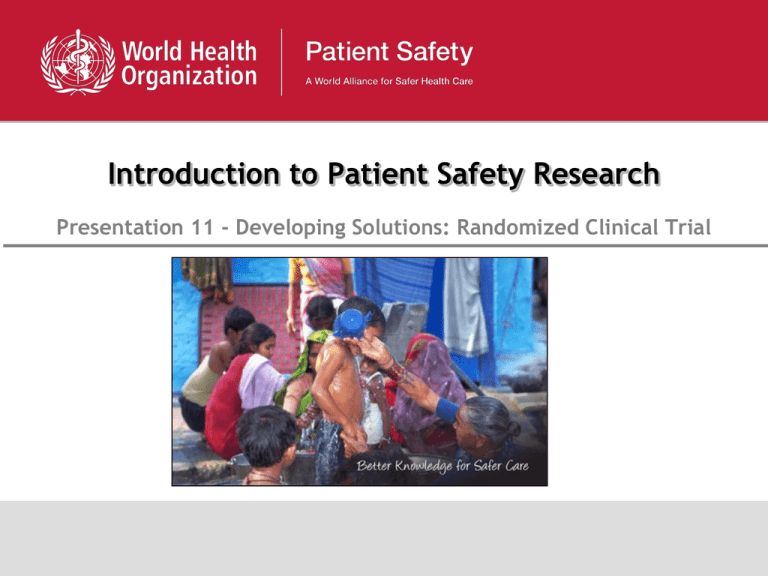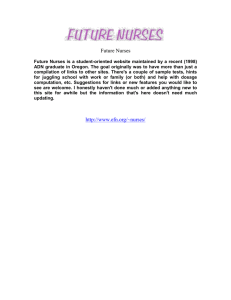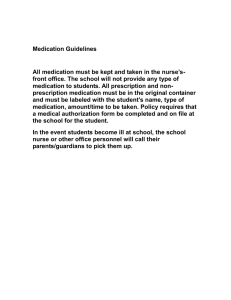
Introduction to Patient Safety Research
Presentation 11 - Developing Solutions: Randomized Clinical Trial
2: Overview
Objectives
Examine whether medication administration error rates could be decreased
by having "dedicated" nurses focus exclusively on administering drugs.
Methods
A randomized study at 2 hospitals (A and B) using a direct observation
technique to record drug errors, process-variation errors, and total errors.
• "Medication nurses," after receiving a brief review course on safe medication use,
responsible solely for drug delivery for up to 18 patients each.
• "General nurses," who did not attend the course, provided comprehensive care,
including drug delivery, for 6 patients each.
Results
At both hospitals combined, the total error rate was 15.7% for medication
nurses and 14.9% for general nurses.
Comparing hospitals, the total error rate for medication nurses at hospital B
was significantly higher than it was at hospital A (19.7% vs 11.2%).
Conclusion
Trial suggests that use of dedicated medication nurses does not reduce
medication error rates, although they might be useful in some settings.
3: Introduction: Study Details
Full Reference
Greengold N, Shane R, Schneider P,Flynn E, Elashoff J,Hoying C,
Barker K, Bolton LB. The Impact of Dedicated Medication Nurses on
the Medication Administration Error Rate: A Randomized Controlled
Trial. Arch Intern Med, 2003:163:2359-2367
Link to Abstract (HTML)
Link to Full Text (PDF)
4: Introduction: Patient Safety Research Team
Lead researcher – Nancy L. Greengold, MD, MBA
Associate Clinical Professor of Medicine, UCLA
Assistant Director of Health Services Research,
Cedars-Sinai Health System in Los Angeles,
California, USA
Other team members
Rita Shane, PharmD
Philip Schneider, RPh
Elizabeth Flynn, PhD
Janet Elashoff, PhD
Cheryl L. Hoying, PhD, RN
Kenneth Barker, PhD, RPh
Linda Burnes Bolton, DrPH, RN
5: Background: Opening Points
Previous study found that prescribing errors represented 56% of
preventable adverse drug events
Errors in medication administration were the second most frequent
type, accounting for 34% of preventable events
Observation technique for studying medication administration
errors, first developed in 1962, used in more than 40 studies
Consistently demonstrated to be the most accurate for detecting
drug administration errors
6: Background: Study Rationale
Nurses have primary responsibility for medication administration
as part of a disparate and demanding set of patient care duties
Medication administration is prone to errors, in part because of the
proliferation of new devices and new drug products
Despite the impressive statistics about adverse drug events it is
believed that the percentages reported actually underestimate
the problem because it is known that most errors go unreported
"I had been discussing various patient safety issues with our
Director of Pharmacy and we both felt that this would be an
important issue to study."
7: Background: Setting Up the Research Team
Selecting collaborators
"We wanted to pull together a multi-disciplinary team so we
invited the Chief Nursing Officer at our institution, who is an
experienced researcher, to join us.
We also solicited the services of an expert statistician at our
institution who contributed greatly to the project.
Because we wanted to examine the issue at two academic medical
centers, we invited a prominent pharmacist and his nurse colleague
at the Ohio State University to join us, as well.
Finally, we wanted to employ an observation technique pioneered
by researchers at Auburn University so we invited two leaders from
this institution to be part of our team."
8: Background: Setting Up a Research Team (2)
Obtaining funding
"We applied for a grant from the National Patient Safety Foundation.
The process was competitive, especially because the principal
investigator (yours truly) had never obtained a grant previously."
9: Background: Objectives
Objectives
To determine if medication administration errors can be decreased
by using a more focused human approach to medication delivery
To test the hypothesis that the drug administration could be
decreased by having "dedicated medication nurses" who:
• have received a brief review course on pharmacology and safe
medication use, and
• focus exclusively on administering drugs during their nursing shifts
without increasing the existing complement of nurse staffing
10: Methods: Study Design
Design: randomized clinical trial
"We felt that a randomized design represented the crème-de-lacrème in research design, and sought to generate results that
would be having the least amount of bias."
Examined whether the medication administration error rate
could be decreased by having “dedicated” nurses focus
exclusively on administering drugs
A direct observation technique was used to record drug errors,
process variation errors, and total errors
11: Methods: Study Population and Setting
Setting: study conducted simultaneously at two academic
hospitals in two contiguous 6-week blocks for 12 weeks
An academic community hospital on the West Coast (Hospital A)
A university teaching hospital in the Midwest (Hospital B)
Population: registered nurses who had at least 1 year of acute
care nursing experience and a minimum of 6 months of fulltime
employment at the hospital
“Medication nurses,” after receiving a brief review course on safe
medication use, responsible solely for drug delivery for up to 18
patients each
“General nurses,” who did not attend the course, provided
comprehensive care, including drug delivery, for 6 patients each
12: Methods: Study Population and Setting (2)
Four nursing units at each hospital were selected to participate
and consent was acquired from nurse volunteers
Hospital A: nursing units aggregated to focus on either medical or
surgical patients
Hospital B: all nursing units involved were mixed medical and
surgical units
Nurses randomly assigned using a random-number generator to
one of two groups: "medication" or "general" nurses
8 medication nurses and 8 general nurses were randomized to
participate as principal study participants
7 medication nurses and 3 general nurses were randomized to
participate as backup study participants to fill in as needed
13: Methods: Medication Use Process
Medication-use processes differed between the two hospitals:
Reproduced from Greengold N, Shane R, Schneider P,Flynn E, Elashoff J,Hoying C, Barker K, Bolton LB. The Impact of Dedicated Medication Nurses on the Medication
Administration Error Rate: A Randomized Controlled Trial. Arch Intern Med, 2003:163:2359-2367. Copyright © 2009 American Medical Association. All rights reserved
14: Methods: Medication Use Process (2)
Reproduced from Greengold N, Shane R, Schneider P,Flynn E, Elashoff J,Hoying C, Barker K, Bolton LB.
The Impact of Dedicated Medication Nurses on the Medication Administration Error Rate: A Randomized
Controlled Trial. Arch Intern Med, 2003:163:2359-2367.
Copyright © 2009 American Medical Association. All rights reserved
15: Methods: Data Collection (1)
Trained observer responsible for following the study participants
unobtrusively during the medication administration process
In the interests of patient safety, observers intervened if a serious
error with potential for patient harm was expected to occur
At the conclusion of each observation shift, observers performed
a “reconciliation” of their observations
Compared medication administration information recorded during
the shift with the physicians’ orders in the medical records
16: Methods: Data Collection (2)
A data collection form was developed to record all observations
during the medication administration process
All aspects of drug retrieval, preparation and administration
Variations from safe medication practices
Medication errors were recorded by the observers
For drugs: dose, dosage form, route, rate of administration
For intravenous drugs: dose preparation, administration
Technique
Omitted drugs
17: Methods: Data Analysis and Interpretation
Error rate was computed for each nursing unit for each hospital
by study week for each nurse type (medication or general)
Statistical significance assessed using the sign test (a test of the null
hypothesis that the probability of a positive difference is 50%)
P values were computed based on the binomial distribution
Conclusions based on the consistency of differences across the
12-week period
18: Results: Demographics
Two medication nurses dropped out of the study and were
replaced by randomized backup medication nurses
Occasionally necessary to recruit nurses to serve as general
nurses when the randomized backup general nurses unavailable
Occurred 12% of the time for total days worked by general nurses
These nurses not randomized
Reproduced from Greengold N, Shane R, Schneider P, Flynn E, Elashoff J, Hoying C, Barker K, Bolton LB.
The Impact of Dedicated Medication Nurses on the Medication Administration Error Rate: A Randomized
Controlled Trial. Arch Intern Med, 2003:163:2359-2367.
Copyright © 2009 American Medical Association. All rights reserved
19: Results: Key Findings
At both hospitals, the combined total error rate was 15.7% for
medication nurses and 14.9% for general nurses
Total error rate for medication nurses at Hospital B (19.7% ) was
significantly higher than at Hospital A (11.2%)
Reproduced from Greengold N, Shane R, Schneider P,Flynn E, Elashoff J,Hoying C, Barker K, Bolton LB.
The Impact of Dedicated Medication Nurses on the Medication Administration Error Rate: A Randomized
Controlled Trial. Arch Intern Med, 2003:163:2359-2367.
Copyright © 2009 American Medical Association. All rights reserved
20: Results: Key Findings (2)
Unit and nurse type comparison within Hospital A
Significantly lower error rate for medication nurses (7.4%)
than for general nurses (17.7%) in the surgical units BUT
No significant differences in total errors comparing nurse
types in the medical units (13.6 vs. 12.4%)
Reproduced from Greengold N, Shane R, Schneider P,Flynn E, Elashoff J,Hoying C, Barker K, Bolton LB.
The Impact of Dedicated Medication Nurses on the Medication Administration Error Rate: A Randomized
Controlled Trial. Arch Intern Med, 2003:163:2359-2367.
Copyright © 2009 American Medical Association. All rights reserved
21: Conclusion: Main Points
This trial suggests that use of dedicated medication nurses does
not reduce medication error rates.
However, subgroup analysis indicates that medication nurses might
be useful in certain settings.
Differences in findings at the two hospitals and differences in
medication-use processes reinforce the concept that medication
errors are usually related to systems design issues
22: Conclusion: Discussion
Simple changes in work design and modest education
intervention do not seem to decrease medication error rates
Not sufficient in diverse hospital populations with complicated
medication-use systems
Likely that more substantive system changed to medication-use
systems and trains are required to reduce medication error rates
Attempting to reduce medication error rates through
comprehensive educational programs requires further study
23: Conclusion: Discussion (2)
Study limitations
Medication nurses received little training (1 day only); results may
be different if given further training and time to develop expertise
Nurses observed between 8AM and 1PM only and hours and shifts
worked by nurses different at each institution
Due to different medication-use processes at each hospital,
observers used different methods in recording errors
24: Conclusion: Practical Considerations
Study duration: approximately one year
Cost: about $99,000 USD
Additional resources
Competencies needed
Designed own data collection forms and used paper to record the
“observation” data
One computer to transfer the paper information into a database
file (all of this work was done by one individual)
Statistics programs to analyze the data
Trained observers (nurses at one institution, pharmacy technicians
at another)
Statistician
Nurses to fill the roles of “medication nurse” and “general nurse”
Ethical approval: took several months to obtain
25: Conclusion: Study Impact
Academic impact
"The article appeared to be of interest primarily to the academic
world.
However, because the results were mostly negative (the trial did
not find a statistically significant difference between total error
rate for so-called medication nurses compared with total error
rate for so-called general nurses), the research did not generate
the type of excitement it might have had we found a statistically
significant difference in error rates."
26: Conclusion: Study Impact (2)
Policy impact
"It’s hard to know if there was any effect on policy. I suppose that
the absence of an effect may have led to a decreased interest in
establishing dedicated medication nurses in hospitals.
That is, had our results demonstrated improved patient safety
from use of medication nurses, institutions might have pressed for
changes in their facilities in this regard."
27: Conclusion: Study Impact (3)
Practice impact
"There may have been an increased awareness of patient safety
issues (and thus improved safety practices) by the nurses who
participated in our study.
Anecdotally, several of them remarked that they paid closer
attention to drug administration when they knew they were being
observed.
But I cannot claim that there was any impact upon patient safety
at these institutions or at institutions that were not part of the
study."
28: Author Reflections: Lessons and Advice
If you could do one thing differently in this study what would it
be?
"I would have made it less complex. There were far too many
variables that muddied the waters – different nurse types,
different care units, different hospitals, different medication use
processes at each hospital, different backgrounds for the
observers, too many definitions of “error.” And I’m only
scratching the surface!"
29: Author Reflections: Overcoming Barriers
What barriers or problematic issues did you encounter when
setting up your research and how did you overcome these?
"We encountered many barriers, but the one that stands out in my
mind is trying to conduct a clean research study with very busy
study subjects, nurses, whose first priority (appropriately) is
trying to take care of patients.
It is very difficult to adhere to all of the rules and regulations of
research in a real-world setting, such as keeping the intervention
and control groups the same size when the clinical staffing
fluctuates day by day.
Also, on some days our research subjects (the nurses) were unable
to work for one reason or another and we had to scramble to get
replacements (including obtaining informed consent)."
30: Author Reflections: Ideas for Future Research
What message do you have for future researchers from
developing countries?
"Research is challenging. It tends to look clean and logical on
paper, but when you are actually conducting it, it is messy and
sometimes confusing."
What would be an important research project you recommend
that they do?
"Any type of research would serve as a learning experience.
I would recommend that new researchers start by doing some
“retrospective” research involving analysis of chart or other data.
Researchers should then build slowly upon their experiences,
advancing to more complicated trial designs as they learn new
lessons."


